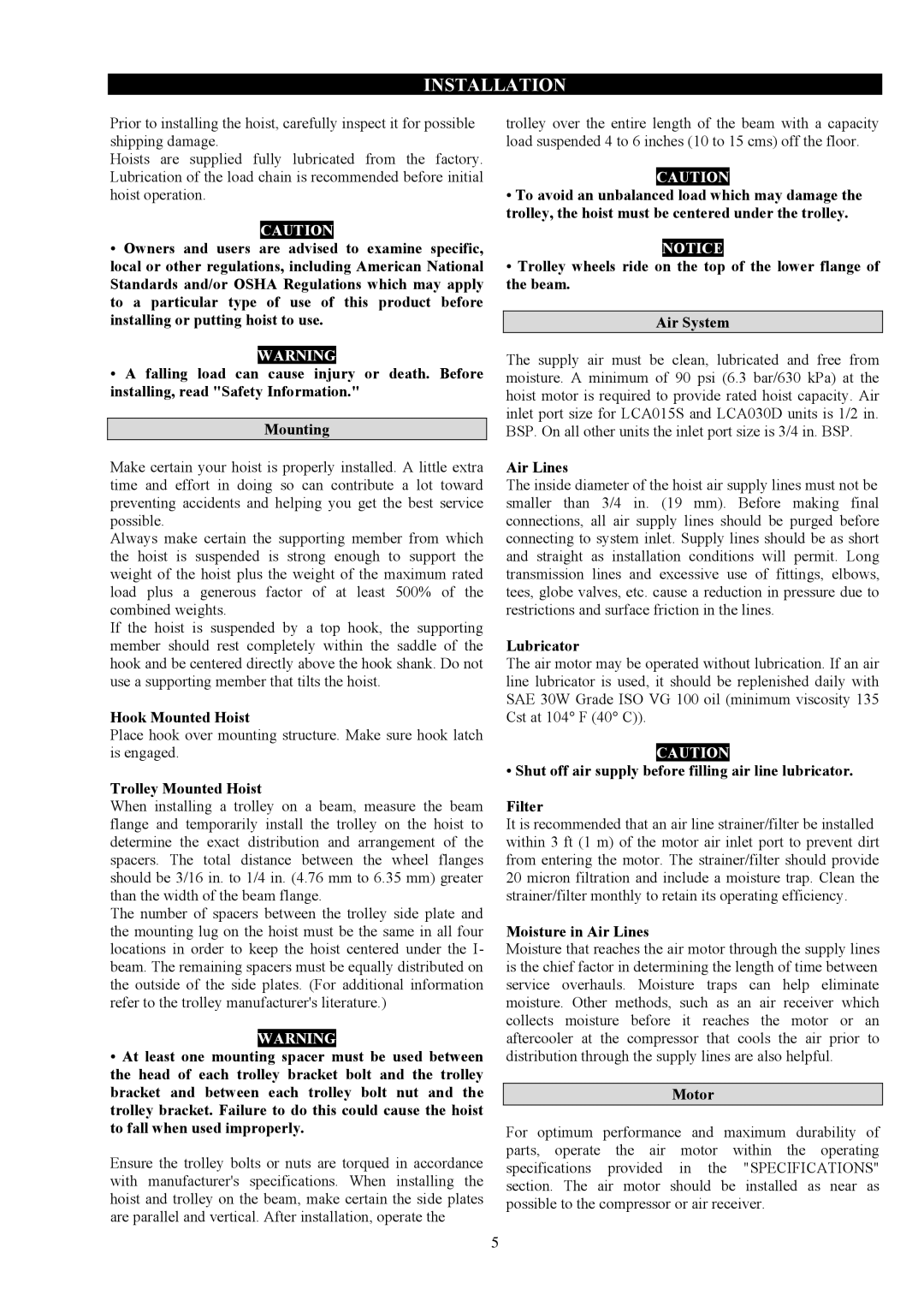
INSTALLATION
Prior to installing the hoist, carefully inspect it for possible shipping damage.
Hoists are supplied fully lubricated from the factory. Lubrication of the load chain is recommended before initial hoist operation.
CAUTION
•Owners and users are advised to examine specific, local or other regulations, including American National Standards and/or OSHA Regulations which may apply to a particular type of use of this product before installing or putting hoist to use.
WARNING
•A falling load can cause injury or death. Before installing, read "Safety Information."
Mounting
Make certain your hoist is properly installed. A little extra time and effort in doing so can contribute a lot toward preventing accidents and helping you get the best service possible.
Always make certain the supporting member from which the hoist is suspended is strong enough to support the weight of the hoist plus the weight of the maximum rated load plus a generous factor of at least 500% of the combined weights.
If the hoist is suspended by a top hook, the supporting member should rest completely within the saddle of the hook and be centered directly above the hook shank. Do not use a supporting member that tilts the hoist.
Hook Mounted Hoist
Place hook over mounting structure. Make sure hook latch is engaged.
Trolley Mounted Hoist
When installing a trolley on a beam, measure the beam flange and temporarily install the trolley on the hoist to determine the exact distribution and arrangement of the spacers. The total distance between the wheel flanges should be 3/16 in. to 1/4 in. (4.76 mm to 6.35 mm) greater than the width of the beam flange.
The number of spacers between the trolley side plate and the mounting lug on the hoist must be the same in all four locations in order to keep the hoist centered under the I- beam. The remaining spacers must be equally distributed on the outside of the side plates. (For additional information refer to the trolley manufacturer's literature.)
WARNING
•At least one mounting spacer must be used between the head of each trolley bracket bolt and the trolley bracket and between each trolley bolt nut and the trolley bracket. Failure to do this could cause the hoist to fall when used improperly.
Ensure the trolley bolts or nuts are torqued in accordance with manufacturer's specifications. When installing the hoist and trolley on the beam, make certain the side plates are parallel and vertical. After installation, operate the
trolley over the entire length of the beam with a capacity load suspended 4 to 6 inches (10 to 15 cms) off the floor.
CAUTION
•To avoid an unbalanced load which may damage the trolley, the hoist must be centered under the trolley.
NOTICE
•Trolley wheels ride on the top of the lower flange of the beam.
Air System
The supply air must be clean, lubricated and free from moisture. A minimum of 90 psi (6.3 bar/630 kPa) at the hoist motor is required to provide rated hoist capacity. Air inlet port size for LCA015S and LCA030D units is 1/2 in. BSP. On all other units the inlet port size is 3/4 in. BSP.
Air Lines
The inside diameter of the hoist air supply lines must not be smaller than 3/4 in. (19 mm). Before making final connections, all air supply lines should be purged before connecting to system inlet. Supply lines should be as short and straight as installation conditions will permit. Long transmission lines and excessive use of fittings, elbows, tees, globe valves, etc. cause a reduction in pressure due to restrictions and surface friction in the lines.
Lubricator
The air motor may be operated without lubrication. If an air line lubricator is used, it should be replenished daily with SAE 30W Grade ISO VG 100 oil (minimum viscosity 135 Cst at 104° F (40° C)).
CAUTION
• Shut off air supply before filling air line lubricator.
Filter
It is recommended that an air line strainer/filter be installed within 3 ft (1 m) of the motor air inlet port to prevent dirt from entering the motor. The strainer/filter should provide 20 micron filtration and include a moisture trap. Clean the strainer/filter monthly to retain its operating efficiency.
Moisture in Air Lines
Moisture that reaches the air motor through the supply lines is the chief factor in determining the length of time between service overhauls. Moisture traps can help eliminate moisture. Other methods, such as an air receiver which collects moisture before it reaches the motor or an aftercooler at the compressor that cools the air prior to distribution through the supply lines are also helpful.
Motor
For optimum performance and maximum durability of parts, operate the air motor within the operating specifications provided in the "SPECIFICATIONS" section. The air motor should be installed as near as possible to the compressor or air receiver.
5
